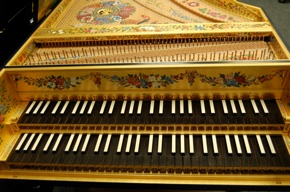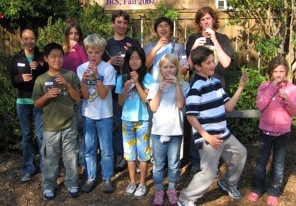Have you heard this complaint? Audience members at early-music concerts, like those at most classical music events, tend to have hair color that lies somewhere between blue and gray. This fact worries many fans, who gripe about cutbacks to school music programs and about a generation more comfortable with instruments with buttons and touch screens than those with five strings or 88 keys. And if this is the state of classical music education in general, then early music’s outlook must be even more bleak. Right?
Wrong — at least in the Bay Area. From private instruction to public school involvement, from fun summer workshops for kids to competitions where professionals judge performers’ artistry, the opportunities forth youth involvement in early music are myriad. What’s more, these opportunities are not limited to San Francisco or Berkeley. Students as far afield as Contra Costa and Yolo counties also have rare opportunities at their fingertips. Here is a discussion of just some of these opportunities, for students still looking for some extracurricular activities.
Private Instruction

The first idea many parents have about music education involves private lessons, but how many think of learning early-music techniques alongside the “mainstream” repertoire?
Of course, sometimes the teachers themselves introduce students to early music. Many professional harpsichordists and Baroque violinists started by studying modern incarnations of their instruments. Some teachers recognize a particular gift for early music and make opportunities available.
One Bay Area instructor who has been particularly successful in this regard is Carlene Reeves, who runs a keyboard studio in Contra Costa County. For 18 years now, Reeves has kept historic keyboard instruments alongside her modern piano. After a couple of years of piano lessons, at about the age of 8 or 9, her students start with Baroque repertoire. When they’re ready, Reeves allows them to play the harpsichord. It’s important to her that they realize that access to that instrument is a special experience. “I play it up as prestigious,” she says.
The approach works. “It’s unreal,” says Reeves, “how excited they are to move to the harpsichord.” What is it that kids like so much about it? At first, says Reeves, “they are curious and want to hear what the instruments sound like. Kids like variety — the more variety, the better.”
But what really excites Reeves about this process is that the kids’ interest is not just a quickly fading novelty. “The harpsichord engages them with music on a new level than the more familiar piano,” she says. “Most of them prefer to play the Baroque repertoire on the harpsichord, once they’ve experienced it, and many really won’t play it on the piano anymore if they don’t have to.” Some of her students have become so excited by the harpsichord that they have gone on to commission instruments from area harpsichord builders and even to study harpsichord at the university level.
That’s not to say that the harpsichord turns Reeves’ students away from the piano altogether. Indeed, it inspires them to approach all music differently. Reeves says that her students become far more conversant with questions of phrasing and articulation — the principal means of expression on the harpsichord — in their piano playing, “up to and including Bartók.” Reeves reports that, after incorporating harpsichord for a couple of years, “I realized that my students who are trained in articulation are using it in all other pieces in all styles. They’re attuned to it, they’re listening for it. It’s just great.”
As far as Reeves knows, she is the only piano teacher in the area using the harpsichord in this way. But the Bay Area has many other harpsichord teachers who welcome children into their studios. There are also private instructors in recorder, Baroque violin, Baroque cello, Baroque flute — the list is almost boundless. The San Francisco Conservatory of Music’s preparatory division is a good place to start.
Recorder Recruits

Of course, among the more important benefits of music making for youngsters are the valuable lessons in communication and social skills that come from playing in an ensemble. Early-music opportunities abound for youngsters and teenagers throughout the Bay Area.
The Junior Recorder Society East Bay Chapter, for example, has been providing group lessons and performance opportunities for children 7 to 18 years old for some 15 years. Directed by Hanneke van Proosdij and Louise Carslake, this group is associated with the American Recorder Society and van Proosdij’s performance organization, Voices of Music. It is, according to van Proosdij, the largest youth recorder society in the U.S. She and cofounder Carslake began the JRS because they had enjoyed playing recorder in Europe, where they both grew up. “Moving here,” Hanneke reports, “we didn’t find any such group music-making opportunities for young recorder players, so we started the JRS.”
The JRS holds monthly meetings in Albany or El Cerrito, in which groups of between 12 and 20 children work together on ensemble music. The repertoire is drawn from the medieval, Renaissance, or Baroque periods, exposing the kids to a huge range of music. At least one big piece is always chosen, to involve everybody, so that younger and less-experienced children get to work with more-advanced students; some pieces are grouped by ability.

The JRS offers two or three performances each year. Recent venues have included a spot on the Berkeley Early Music Festival, the Berkeley Public Library, and a performance for adult players at a meeting of the East Bay chapter of the American Recorder Society. Miniature performances are given at the end of each meeting, when parents are invited to listen to the work that the students have been doing during that month’s session.
Van Proosdij is involved with even more recorder education through the San Francisco Early Music Society’s after-school program. The SFEMS program has been running for some two decades, and currently consists of four recorder programs and one choir. These sessions take place in Albany and Berkeley schools at the elementary and middle school level. Van Proosdij stresses that these programs are important: “They’re keeping music in the school, where the normal state education funding is failing us.”
Early Music in the Schools: Drawing a Crowd(en)
Yet not all schools are failing with music education. In at least two schools in the Bay Area, students can get continuous exposure to early-music activities as part of their regular curricula. The most famous of these is the private Crowden Music Center in north Berkeley. This school serves students between the fourth and eighth grades, who receive a full range of fully accredited academic courses, which are carefully balanced and coordinated with musical activities.

The early-music program is a fine example of the best that Crowden has to offer. Lisa Grodin, the director, explains that “students begin to understand the historic and political context of each period [of music history] through history and music history classes,” while learning specialized music theory like “traditional harmony, counterpoint, and [Baroque] structural forms.” Piano students can take continuo (accompaniment) classes, while more-advanced students have the opportunity to work in small Baroque ensembles. Guest artists like violinist Monica Huggett and Jeffrey Thomas (director of the American Bach Soloists) have given master classes to Crowden students, and regular field trips to Philharmonia Baroque Orchestra’s student concerts expose Crowden students to the highest caliber of early-music making.
When asked about the particular benefits of teaching early music to Crowden students, Grodin gets excited. “The study of early music,” she says, “helps develop purity of intonation, rhythmic clarity, and harmonic understanding; and leads one to explore a special range of timbre on strings or keyboard instruments. Learning about the role of the ‘continuo team’ in Baroque ensemble playing can be very exciting ... [and] it can also be eye-opening to discover the opportunities for improvisation and embellishment inherent in this style of music.”
Singular Sensation at Davis High
Featured Video
Now, it may not be all that surprising that an elite private arts academy might be able to have Baroque ensembles jamming in its hallways, but Bay Area residents should also be proud to know that the public Davis High School boasts what is likely the only full-fledged high school Baroque orchestra in the country.
Its Baroque Ensemble is an auditioned group, with between 26 and 34 students involved during each school year. Students play Baroque violin, viola, cello, bass, or harpsichord, and perform original scores by 17th- and 18th-century masters.
Angelo Moreno, the director of the DHS Orchestra Program, has been working for a decade now toward having a Baroque orchestra in his high school. He was inspired by his experiences as a member of the UC Davis Baroque ensemble to bring this repertoire to younger students. He has worked hand in hand with the nonprofit Davis Schools Orchestra Music Association to acquire funds for instruments and additional teachers, such as UC Davis’ Phebe Craig, who now coaches on continuo with the ensemble’s harpsichordists.

The ensemble uses historically appropriate instruments provided by the school, and the students are allowed to take the instruments home to practice. These instruments include Baroque string instruments with gut strings (as opposed to metal ones) and appropriate bows, all reconditioned by luthier and Baroque instrument expert Devin Hough. The high school also possesses a fabulous harpsichord, by Berkeley’s famed John Phillips. Few high schools in the world own an expensive John Phillips French double-harpsichord. But then, few high schools in the country can boast of having their own Baroque orchestra, either.
If you’re raising your eyebrows in surprise that a public high school has such a curriculum, you’ll be interested to know that Davis High School’s full music program involves no fewer than 448 music students, and 154 enrolled in orchestras. With numbers like that, Moreno was able to argue for more course offerings to cut down on class size. “Luckily,” he reports, “my proposal [for a Baroque orchestra] went on to get a unanimous vote by the DJSUD School Board. The School Board in general, unlike many other towns, has always been incredibly supportive of arts education and our District Music Program in general.” Indeed, there is massive support throughout the district: Overall, the district has more than 2,000 music students, “a huge source of positive recognition,” according to Moreno.
This group will strut its stuff in no fewer than six concerts this year. The earliest one is on Oct. 2. Concert details are at the bottom of this article.
But Wait, There’s (Even) More!
A little research on this topic turns up a wonderfully frustrating fact — there are too many early-music opportunities for kids in the Bay Area to be described in one place. For instance, the Music Discovery Workshop, founded in 1994 and run under the auspices of SFEMS, currently hosts between 25 and 30 students ranging from 7- to 15-year-olds every summer. In Contra Costa County, a student Baroque Festival has been running for 15 years; the festival is open to anyone, at any ability level. The Jr. Bach Society is a similar festival, aimed a higher ability levels, and based in Berkeley. Marie Dalby leads viol consorts for teenagers. And there are scores of private teachers whose names don’t appear in this article.
In a little over a month, SFCV will have a large and thorough section devoted to teachers and educational resources in the Bay Area, but for now the San Francisco Early Music Society is probably the first point of contact for most people seeking additional information about early-music education.
Moreover, for those who just like to listen, there are also education programs available for children from the major period-instrument groups in the Bay Area. The Philharmonia Baroque Orchestra, for one, has a growing education and outreach program that takes the group to schools for concerts, master classes, and lectures; provides free student concerts; hosts an annual family concert; and does much more. PBO also offers discounted student ticket prices at its regular concerts, as do the American Bach Soloists and virtually every other ensemble in the area.
Considering all these opportunities for youngsters to hear Baroque music performed by period specialists, along with the hands-on early-music activity in this area, we can rest easy: Early-music concerts in this region are going to be attended by educated — and able — audience members for decades to come.
Further Information at a Glance
Links and further information on all these groups are included below. All these groups depend on private donations to operate. If you are interested in donating, or merely want more information about the programs, call or click one of the links below.
S.F. Conservatory Preparatory Division: www.sfcm.edu
Junior Recorder Society, East Bay Chapter: www.voicesofmusic.org Contact person: Hanneke van Proosdij
San Francisco Early Music Society
Info about after-school programs: mailto:[email protected].
Info about the summer Music Discovery Workshop: www.sfems.org
Crowden Music Center: www.crowden.org
Davis High School Baroque Ensemble: www.dsoma.org
Junior Bach Society: www.juniorbach.org
Contra Costa Baroque Festival info at: www.ccmtac.com
Philharmonia Baroque Orchestra’s Education Program: www.philharmonia.org
Upcoming concerts:
Free Student Concert I: Nov. 5, 1:30 p.m., Herbst Theatre, S.F.
Family Concert: Nov. 6, 4 p.m., First Congregational Church, Berkeley.

